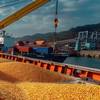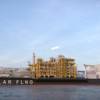Dockwise Q2 2009 Results
Dockwise Ltd. announced its second quarter and interim 2009 results.
André Goedée, CEO of Dockwise Ltd., commented:
"Dockwise has had a good second quarter, and in quieter market conditions the business is displaying its strengths. This steady operational performance has allowed us significantly to deleverage the business by nearly USD 100 million in the first half of 2009, and we continue in our efforts to strengthen the balance sheet. Stringent cost discipline and a stop on hiring of new personnel is and will be continued.
Dockwise's global spread has given us access to business wherever it has emerged, while utilization rates of over 90 per cent have sustained a healthy EBITDA margin and strong cash generation. With rig transportation levels lower than in recent record periods, the growing significance of our non oil-and-gas-related business to the revenue mix is apparent. Contractual delays, as previously indicated, continue to be an influencing factor, but we are encouraged to see no slow down in tendering activity.
We are greatly encouraged by the support we have received from clients as we develop our business, particularly in respect to our services in risk areas such as Nigeria and the Gulf of Aden. As always, the safety of our crew and their cargoes are our highest priority, and we are encouraged to see concerted international action to police the waters off the Horn of Africa."
After the peak activity levels for rig transport in recent quarters, Dockwise’s transportation schedule for Q2 2009 displays a more balanced range of projects together with the timely use of surveys and dry-docking to maintain utilization rates in a quieter period., The operational activities of note were the commencement of the CPOC floatover, a sizeable task contracted in its entirety to Dockwise, and the movement of a variety of cargoes for military and port infrastructure clients. These varied from submarine transports for the Russian navy to harbour cranes and dredging equipment. Dockwise also secured its first involvement in renewable energy with the transport of barges for the installation of wind turbines in the North Sea. Finally, though lower profile than in prior quarters, the conventional rig service delivered four completed transports, making a useful contribution to profits.
Despite the current economic downturn, Dockwise Yacht Transport (DYT), on a through-cycle view, addresses a valuable, growing, global niche. To that end, we recently announced plans to merge DYT with Yacht Path International, as a wholly owned subsidiary of Dockwise, to serve a substantially enlarged segment of the yacht transport market. Yacht Path focuses on craft of up to 80 feet in length with lift-on / lift-off transport services, whereas DYT serves the 80 foot and larger segment with float-on / float-off services.
Total revenue increased by 2.4% to USD 118.7 million in Q2 2009 vs. USD 115.9 million in Q2 2008. On an adjusted basis, revenues fell, prompted by a lower contribution in Q2 from escrow accounts relating to the reinstatement of MS3 (3 months or USD 9.7 million in Q2 2008 versus 1 month or USD 3.2 million in Q2 2009). Market conditions in Q2 were characterized by even shorter lead times than in Q1 2009. Price levels remained constant but utilization levels fell slightly, chiefly due to an increased number of survey and docking days. Specifically, the docking of the Black Marlin and the Blue Marlin had an impact as these vessels represent high value contracts. The contribution of Offshore/Onshore projects increased significantly to USD 16.3 million (Q2 2008 USD 7.0 million) as the mobilization and preparation for the CPOC float-over contract commenced. In addition, Dockwise’s subsidiary Offshore Kinematics Inc. had two large contracts in progress in support of third party float-over projects.
As the revenue-mix in Q2 2009 included more Offshore/Onshore related income, the according cost structure is visible in relatively higher direct costs for the period. Furthermore, direct expenses include costs incurred in repositioning three uncontracted vessels to areas where near term projects are anticipated. The rising threat of piracy in certain areas has led to additional costs for protection of our crews, cargoes and vessels. For DYT, the sharp decrease in direct costs to USD 5.0 million (Q2 2008 USD 9.7 million) was the result of markedly higher fuel costs during the comparable period in 2008 and a lower activity level in Q2 2009.
The growth in vessel operating costs, by USD 0.5 million compared to Q2 2008, is directly related to the expansion of the fleet.
Depreciation charges increased by USD 6.7 million compared to Q2 2008 and are the consequence of the fleet optimization programme with a rise in the number of higher value Type II vessels and divestment of type IV vessels Dock Express 10 and 12. The depreciation charges also include charges for assets specifically used for float-over projects, while the amortization charge (USD 1.2 million) mainly relates to customer relationships and technology. Q2 2008 included USD 0.5 million for amortization of backlog which was fully amortized by the end of Q2 2008.
Selling, general and administrative expenses (SG&A) in Q2 2009 are largely in line with Q1 2009 and fell by USD 0.4 million compared to Q2 2008. SG&A expenses also reflect the weakening dollar during the period, particularly since G&A costs largely include Euro-denominated expenses. Our ongoing cost control programme continues to target all areas of the business. 5
The EBITDA margin increased to 48.9%, as against 42.2% in Q2 2008. This growth over Q2 2008 was largely driven by an improved EBITDA margin at DYT and one-off effects relating to the reinstatement of the Mighty Servant 3.
Adjusted EBITDA, including non-recurring proceeds from the sale of DE12 (USD 1.9 million), rose by 8.7% to USD 60.1 million (USD 55.2 million Q2 2008). The chief factors were the expansion of the fleet and overall average higher contract values, combined with a reduction in the level of direct and administrative expenses.
Non-current interest bearing liabilities and current maturities of interest bearing borrowings reflect the outstanding USD 963 million amount (Q1 2009 USD 1.021 billion) under the USD 1.1 billion Senior Facility, less capitalized arrangement fees of USD 20 million. The debt reduction in Q2 2009 included the repayment from the Mighty Servant 3 escrow proceeds (USD 40.6 million), a scheduled repayment (USD 5.0 million), and a repayment relating to the divestment of the Dock Express12 (USD 4.0 million). The Debt Buy Back programme led to a debt reduction of USD 8.1 million for a cash outlay of USD 5.8 million.
Interest expenses on total debt of currently 6.7% are based on LIBOR plus, on average, a 2.65% margin. Approximately 80% of total interest exposure has a hedged LIBOR at 4.01%. Net financing costs decreased to approximately USD 18.7 million in Q2 2009 (Q2 2008 USD 20.6 million). Net financing costs for Q2 2009 include a USD 1 million non-recurring impairment of capitalized loan fees (non-cash) relating to the debt reduction in Q2 2009.
Net profit for Q2 2009 amounted to USD 17.0 million (USD 12.6 million in Q2 2008). At June 30, 2009, a total of 229,755,438 shares were outstanding. The net profit per share over the second quarter of 2009 amounted to USD 0.07 (NOK 0.44) and for the first six months of 2009 USD 0.19 (NOK 1.23).
CAPEX for the quarter came in at USD 12.4 million mainly related to the docking of the Black Marlin and the Blue Marlin, the construction of the world’s largest test press by Offshore Kinematics Inc. and own-scope improvements to the Mighty Servant 3.
In general, working capital is inherently volatile reflecting the specific timing of payments by clients under our contracts. Dockwise’s working capital requirement is negative on a structural basis since both Heavy Marine Transport and Offshore/Onshore projects have pre- financing contract conditions for clients.
Dockwise divested of Dock Express 12 in Q2 2009 as part of the fleet optimization programme. Dock Express 12 was an almost fully depreciated Type IV vessel with relatively low revenue contributions. With its divestment, a book profit of USD 1.9 million was realized and the received compensation of USD 4.0 million was utilized to redeem long term loans. The Mighty Servant 3 returned to service in August 2009 following sea trials and formal reinstatement.
Total backlog for Dockwise Heavy Lift amounted to USD 367 million (Q1 2009 USD 407 million). Of the backlog some 30% relates to projects for 2009, 51% to projects for 2010 another 19% to projects for 2011 and beyond. Lead times for Heavy Marine Transport projects proved to be even shorter than in the first quarter of 2009, and this contributed significantly to the headline fall in backlog. However, the scale of the Dockwise fleet, being markedly greater than competitors’, ensures a world-wide dispersal of vessels and a valuable flexibility in competing for short lead time contracts. Post period end, Dockwise has secured an additional USD 50 million in new term contracts for execution in 2009.
Overall, Dockwise’s backlog is composed of projects with significantly differing lead times. One aspect of the Group’s commercial strategy is to focus on improving the proportion of long lead-time projects in the backlog to enhance revenue stability and earnings visibility. At the same time, the Dockwise management team maintains the Group’s established primacy in the short-term contracting market for the transportation of existing rigs and various cargoes.
With major and national oil companies maintaining their exploration and development programmes, there is little evidence of cancellations or longer term reduced mobility in the rig market. However, clients continue to be cautious before contracting transport services. Moreover delays to financing arrangements are holding up the finalization of contracts for new build rigs and equipment. Encouragingly, tender opportunities for the largest and most technically challenging Transport, Installation & Logistics projects are showing steady growth and as an organization, Dockwise is learning how to secure these contracts.
The outlook for Dockwise’s 2009 performance remains good, even though shortening lead times for certain market segments, particularly rig transports, are not contributing to visibility. Based on the results for the first half, together with the current backlog and tender activity, Dockwise expects to deliver a financial performance for 2009 in line with expectations and to perform comfortably within its banking covenants. In the current economic climate, our internal net debt / EBITDA target of 3 by the end of 2009 is more challenging, although management regard it as an achievable goal in the near to medium term.
For 2010, a clearer outlook is forming, where the transformation of Dockwise into a full service maritime transportation company has secured a number of major scale projects,
(www.dockwise.com)











